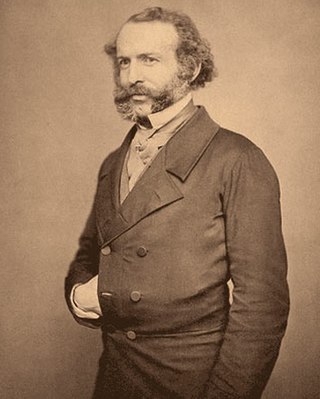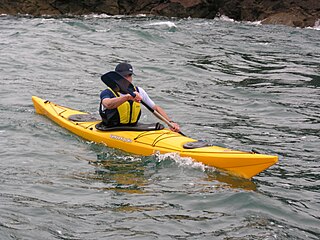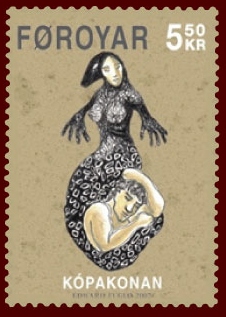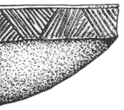
Finn-men, also known as, Muckle men, Fion and Fin Finn, were Inuit sighted in the 17th century around the Northern Isles of Scotland.

Finn-men, also known as, Muckle men, Fion and Fin Finn, were Inuit sighted in the 17th century around the Northern Isles of Scotland.
The first recorded sighting was in Orkney, in 1682. [1] James Wallace, writing in about 1688, described a Finn-man in his "little Boat" at the south end of Eday being seen by the people of the island from the shore, and then fleeing swiftly when the islanders put out a boat to try and apprehend him. [1] In 1684, a Finn-man seen at Westray was connected with the disappearance of fish from the area. [1] A boat was captured in Orkney, and sent to the Physicians Hall in Edinburgh. [1] [2]
The "Finn-men" were initially identified as "Finns", an umbrella term used in the local language of the Orcadians to denote either Sami, Kven or Forest Finns. However, these "Finn-men" were in fact Inuit from the Davis Strait region, a fact recognised by Wallace. [1] As it was considered more probable that they had sailed to the islands from the Cap of the North, the misnomer persisted nonetheless, possibly due to certain phonological similarities between the Greenlandic language spoken by the kayakers and the Finnic languages. [3] [ failed verification ]
Wallace's eldest son James added a note to a 1700 publication of his father's account, suggesting they had been driven off course to Scotland by storms. [1] The most likely reason for their arrival is that they were escaped prisoners, having been taken by European ships as exotic curiosities. [4] [5] Such was the concern about this practice that in 1720 the States General of the Netherlands passed a law prohibiting the murder or kidnapping of Inuit. [5]
John Brand, in A Brief Description of Orkney, described a sighting of a Finn-man. [5]
There are frequently Finmen seen here upon the coasts, as one about a year ago on Stronsa, and another within these few months on Westra, a gentleman with many others in the isle looking on him nigh to the shore, but when any endeavour to apprehend them, they flee away most swiftly; which is very strange, that one man, sitting in his little boat, should come some hundred of leagues from their own coasts, as they reckon Finland to be from Orkney; it may be thought wonderful how they live all that time, and are able to keep the sea so long. His boat is made of seal skins or some kind of leather, he also hath a coat of leather upon him, and he sitteth in the middle of his boat, with a little oar in his hand, fishing with his lines: and when in a storm he sees the high surge of a wave approaching, he hath a way of sinking his boat, till the wave pass over, least thereby he should be overturned. The fishers here observe that these Finmen or Finland-men by their coming drive away the fishes from the coasts. One of their boats is kept as a rarity in the Physicians Hall in Edinburgh.
Kayaks belonging to Finn-men are preserved in Edinburgh and Aberdeen. [6]
The Finn-men were grafted onto the existing mythologies that surrounded the selkies and Finfolk, to the point that both creatures may have both been the same in folklore. [7] Their appearance was interpreted in terms of those traditions. [3]
The history of the Finnmen is discussed in the Red Bull TV series Explorers in the episode "Journey of the Finnmen". [8]

Skara Brae is a stone-built Neolithic settlement, located on the Bay of Skaill in the parish of Sandwick, on the west coast of Mainland, the largest island in the Orkney archipelago of Scotland. It consisted of ten clustered houses, made of flagstones, in earthen dams that provided support for the walls; the houses included stone hearths, beds, and cupboards. A primitive sewer system, with "toilets" and drains in each house, included water used to flush waste into a drain and out to the ocean.

Manannán or Manann, also known as Manannán mac Lir, is a sea god, warrior, and king of the otherworld in Gaelic mythology who is one of the Tuatha Dé Danann.

John Rae was a Scottish surgeon who explored parts of northern Canada. He was a pioneer explorer of the Northwest Passage.

The Kingdom of the Isles, also known as Sodor, was a Norse-Gaelic kingdom comprising the Isle of Man, the Hebrides and the islands of the Clyde from the 9th to the 13th centuries AD. The islands were known to the Norsemen as the Suðreyjar, or "Southern Isles" as distinct from the Norðreyjar or Northern Isles of Orkney and Shetland. In Scottish Gaelic, the kingdom is known as Rìoghachd nan Eilean. The territory is sometimes called the Kingdom of Mann and the Isles, although only some of the later rulers claimed that title. The historical record is incomplete, and the kingdom was not a continuous entity throughout the entire period. At times the rulers were independent of external control, although for much of the period they had overlords in Norway, Ireland, England, Scotland or Orkney. At times there also appear to have been competing claims for all or parts of the territory. The islands have a total land area of over 8,300 square kilometres (3,205 sq mi) and extend for more than 500 kilometres (310 mi) from north to south.
David MacRitchie was a Scottish folklorist and antiquarian. He proposed that stories of fairies originated with an aboriginal race that occupied the British Isles before Celts and other groups arrived.

A sea kayak or touring kayak is a kayak used for the sport of paddling on open waters of lakes, bays, and oceans. Sea kayaks are seaworthy small boats with a covered deck and the ability to incorporate a spray deck. They trade off the manoeuvrability of whitewater kayaks for higher cruising speed, cargo capacity, ease of straight-line paddling (tracking), and comfort for long journeys.

Shapinsay is one of the Orkney Islands off the north coast of mainland Scotland. With an area of 29.5 square kilometres (11.4 sq mi), it is the eighth largest island in the Orkney archipelago. It is low-lying and, with a bedrock formed from Old Red Sandstone overlain by boulder clay, fertile, causing most of the area to be used for farming. Shapinsay has two nature reserves and is notable for its bird life. Balfour Castle, built in the Scottish Baronial style, is one of the island's most prominent features, a reminder of the Balfour family's domination of Shapinsay during the 18th and 19th centuries; the Balfours transformed life on the island by introducing new agricultural techniques. Other landmarks include a standing stone, an Iron Age broch, a souterrain and a salt-water shower.

The Northern Isles are a chain of islands of Scotland, located off the north coast of the Scottish mainland. The climate is cool and temperate and highly influenced by the surrounding seas. There are two main island groups: Shetland and Orkney. There are a total of 36 inhabited islands, with the fertile agricultural islands of Orkney contrasting with the more rugged Shetland islands to the north, where the economy is more dependent on fishing and the oil wealth of the surrounding seas. Both archipelagos have a developing renewable energy industry. They share a common Pictish and Norse history, and were part of the Kingdom of Norway before being absorbed into the Kingdom of Scotland in the 15th century. The islands played a significant naval role during the world wars of the 20th century.

Selkies are mythological creatures that can shapeshift between seal and human forms by removing or putting on their seal skin. They feature prominently in the oral traditions and mythology of various cultures, especially those of Celtic and Norse origin. The term “selkie” derives from the Scots word for “seal”, and is also spelled as silkies, sylkies, or selchies. Selkies are sometimes referred to as selkie folk, meaning 'seal folk'. Selkies are mainly associated with the Northern Isles of Scotland, where they are said to live as seals in the sea but shed their skin to become human on land.

Unstan ware is the name used by archaeologists for a type of finely made and decorated Neolithic pottery from the 4th and 3rd millennia BC. Typical are elegant and distinctive shallow bowls with a band of grooved patterning below the rim, a type of decoration which was created using a technique known as "stab-and-drag". A second version consists of undecorated, round-bottomed bowls. Some of the bowls had bits of volcanic rock included in the clay to make them stronger. Bone tools were used to burnish the surfaces to make them shiny and impermeable.

Transport in Scotland is facilitated by road, rail, air and water networks. The Scottish Government and Scottish Parliament has control over most elements of transport policy within Scotland, with the Cabinet Secretary for Transport holding portfolio responsibility within the Scottish Government. Transport Scotland is the Executive Agency responsible for the Scottish transport network.

The Norse–Gaels were a people of mixed Gaelic and Norse ancestry and culture. They emerged in the Viking Age, when Vikings who settled in Ireland and in Scotland became Gaelicised and intermarried with Gaels. The Norse–Gaels dominated much of the Irish Sea and Scottish Sea regions from the 9th to 12th centuries. They founded the Kingdom of the Isles, the Kingdom of Dublin, the Lordship of Galloway, and briefly ruled the Kingdom of York. The most powerful Norse–Gaelic dynasty were the Uí Ímair or Ivar dynasty.

The High Middle Ages of Scotland encompass Scotland in the era between the death of Domnall II in 900 AD and the death of King Alexander III in 1286, which was an indirect cause of the Wars of Scottish Independence.

Orcadians, also known as Orkneymen, are an ethnic group native to the Orkney Islands, who speak an Orcadian dialect of the Scots language, a West Germanic language, and share a common history, culture and ancestry. Speaking Norn, a native North Germanic language into the 19th or 20th century, Orcadians descend significantly from North Germanic peoples, with around a third of their ancestry derived from Scandinavia, including a majority of their patrilineal line. According to anthropological study, the Orcadian ethnic composition is similar to that of Icelandic people; a comparable islander ethnicity of North Germanic origin.

Scotland was divided into a series of kingdoms in the Early Middle Ages, i.e. between the end of Roman authority in southern and central Britain from around 400 AD and the rise of the kingdom of Alba in 900 AD. Of these, the four most important to emerge were the Picts, the Gaels of Dál Riata, the Britons of Alt Clut, and the Anglian kingdom of Bernicia. After the arrival of the Vikings in the late 8th century, Scandinavian rulers and colonies were established on the islands and along parts of the coasts. In the 9th century, the House of Alpin combined the lands of the Scots and Picts to form a single kingdom which constituted the basis of the Kingdom of Scotland.
Ljótólfr is a minor character in the mediaeval Orkneyinga saga, who is purported to have flourished in the mid-12th century. The Orkneyinga saga was compiled in about 1200, and documents the reigns of the earls of Orkney. It depicts Ljótólfr as a nobleman who lived on the Outer Hebridean Isle of Lewis. During the 12th century, the Hebrides formed part of the Kingdom of Mann and the Isles.

Scandinavian Scotland was the period from the 8th to the 15th centuries during which Vikings and Norse settlers, mainly Norwegians and to a lesser extent other Scandinavians, and their descendants colonised parts of what is now the periphery of modern Scotland. Viking influence in the area commenced in the late 8th century, and hostility between the Scandinavian earls of Orkney and the emerging thalassocracy of the Kingdom of the Isles, the rulers of Ireland, Dál Riata and Alba, and intervention by the crown of Norway were recurring themes.

Prehistoric art in Scotland is visual art created or found within the modern borders of Scotland, before the departure of the Romans from southern and central Britain in the early fifth century CE, which is usually seen as the beginning of the early historic or Medieval era. There is no clear definition of prehistoric art among scholars and objects that may involve creativity often lack a context that would allow them to be understood.

The blue men of the Minch, also known as storm kelpies, are mythological creatures inhabiting the stretch of water between the northern Outer Hebrides and mainland Scotland, looking for sailors to drown and stricken boats to sink. They appear to be localised to the Minch and surrounding areas to the north and as far east as Wick, unknown in other parts of Scotland and without counterparts in the rest of the world.